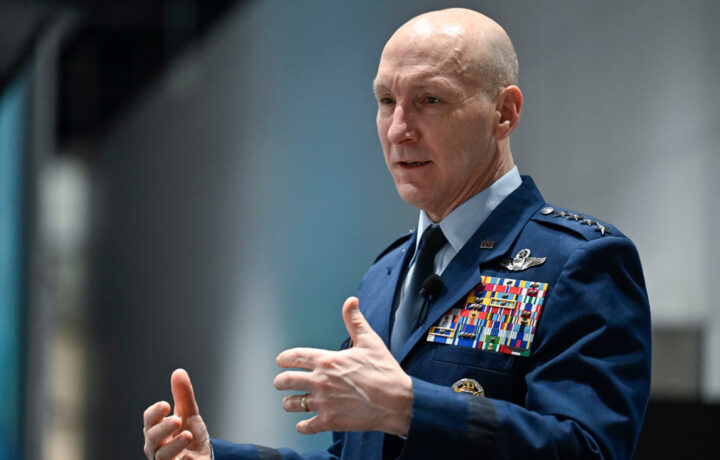Last month, United States Air Force Chief of Staff Gen. David W. Allvin told airmen in an email that the service will begin setting up the first of five Deployable Combat Wings, and requested volunteers for those units.
This week, the Air Force identified those Regular Air Force candidate locations that will receive the DCW Unit Type Code (UTC), which will include the 19th Airlift Wing, Little Rock Air Force Base (AFB), Arkansas; 23rd Wing, Moody AFB, Georgia; the 366th Fighter Wing, Mountain Home AFB, Idaho; the 4th Fighter Wing, Seymour Johnson AFB, North Carolina; and the 20th Fighter Wing, Shaw AFB, South Carolina.
The goal of this change is to allow the U.S. Air Force is able to deploy its forces, which involve moving away from it described as a “crowd-sourced model” to one where airmen from the same installation deploy together as part of a mission-ready “Unit of Action” that may be better suited for today’s fight. The change also acknowledged that airmen would be able to train together, which could result in improved team cohesion when the units arrive in theater, where they could operate as a lethal team.
“We are transitioning our Deployment Model to best meet the evolving national security environment,” Allvin said in the recent memo to Airmen. “At the heart of this transformation is the creation of the Deployable Combat Wing Unit Type Codes – a shift in how we prepare for and execute deployments.”
It is the latest update to the Air Force Force Generation (AFFORGEN) 24-month cycle, which includes four six-month phases – Prepare, Certify, Available, and Reset – designed to ensure a sustainable and ready force for deployments.
Coming Soon – Two Dozen DCWs
The eventual goal is to have 24 Deployable Combat Wings across the United States Air Force, including active service, guard, and reserve units. Each will train and deploy together from their home installation.
“The new concept will create several organizations capable of conducting deployed combat operations, as well as base defense. Under this future construct, base, institutional and combat missions will transition into distinct organizations – called Institutional Wings and Combat Wings – each with separate commanders,” the Air Force announced last September. “Air Force combat wings will be structured as mission-ready Units of Action, with all the necessary elements stationed together at the same installation, where they can train together on a day-to-day basis.”
The Air Force Personnel Center will head up the necessary permanent changes of station, while it maximize volunteer opportunities to provide the required manpower at the initial five installations, pending final approval in the strategic basing process. Air Force leaders have called for airmen to “lean into this organizational change and be eager to take on the challenges and rewards” that will come with DCW.
The service has not identified what other bases will eventually receive the DCW UTCs.
Volunteers Needed
The service is now looking for volunteers, and according to a report from Air & Space Forces magazine, the Air Force has called for 700 airmen across the five locations, and if there aren’t enough volunteers, airmen could be non-voluntarily assigned to units.
In the memo to airmen, Allvin further emphasized the need for “highly motivated airmen,” who are ready to work together to “enhance combat readiness [and] deliver decisive airpower from day one.”
DCW UTCs are part of the newest phase in the evolution of how the U.S. Air Force presents and deploys forces, and it is now expected to replace the Expeditionary Air Base and Air Task Force – with the former expected to sunset in fiscal year 2027 while the latter could be phased out in fiscal year 2028 (FY28). This phased approach, which will require more than one type of unit of action, has been seen as necessary to ensure near-continuous crisis response availability and sustained readiness for the force while DCW UTCs are under construction.
Watchdog Response
Following the Air Force’s implementation of AFFORGEN last year, the Government Accountability Office (GAO) analyzed Air Force documentation and conducted interviews with Department of Defense (DoD) and Air Force officials, and even visited selected major commands and units to identify any challenges in implementing AFFORGEN. The watchdog subsequently made four recommendations to the Air Force, including that “it completes an assessment of minimum U.S. base staffing needs and issues an implementation plan for AFFORGEN that includes goals, a timeline with key milestones, and performance measures.”
The Pentagon concurred with the recommendations, and the service has taken steps to address some challenges in implementing its new process to organize and deploy its forces, though the Air Force continues to face a variety of ongoing challenges, according to the watchdog group.
“To address lessons from early deployments,” the GAO added, “Air Force has revised the composition of these forces and tailored the AFFORGEN process to specific types of units, such as bombers.”




